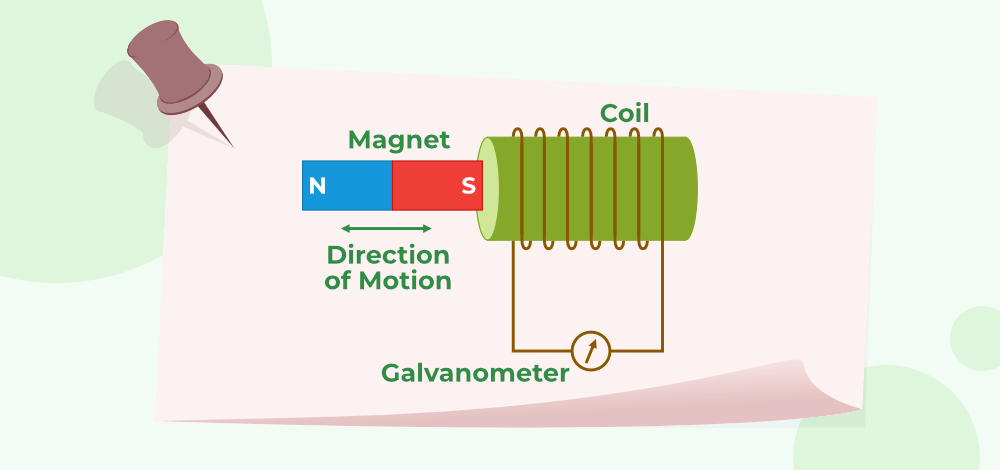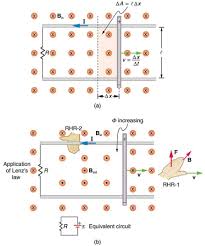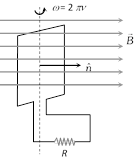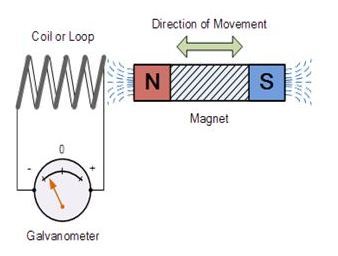
CBSE Class 12 Physics Notes Chapter 6: Here are the notes for CBSE Class 12 Physics Chapter 6 Electromagnetic Induction. This chapter explains the phenomenon of electromagnetic induction, where a changing magnetic field induces an electric current in a conductor.
The chapter covers important concepts such as Faraday's Law of Induction, Lenz's Law, and the concept of eddy currents. Understanding these principles is important as they form the basis for many electrical devices, such as transformers and electric generators. These notes will help you grasp the key points and prepare effectively for your exams.CBSE Class 12 Physics Notes Chapter 6 Electromagnetic Induction Overview
These notes are prepared by subject experts of Physics Wallah and provide an in-depth overview of CBSE Class 12 Physics Chapter 6 Electromagnetic Induction. These notes are designed to help students understand how changing magnetic fields can create electric currents, a principle that is essential in various applications like transformers, electric motors, and generators. These expert-prepared notes will help students in mastering the key concepts and excelling in their exams.CBSE Class 12 Physics Notes Chapter 6 PDF Download
Here we have provided CBSE Class 12 Physics Notes Chapter 6 Electromagnetic Induction PDF for the ease of students so that they can prepare better for their exams by downloading the PDF easily and using it without any internet.CBSE Class 12 Physics Notes Chapter 6 Electromagnetic Induction PDF
CBSE Class 12 Physics Notes Chapter 6 Electromagnetic Induction
Here we have provided CBSE Class 12 Physics Notes Chapter 6 Electromagnetic Induction-Magnetic Flux
 As per the Class 12 Physics Chapter 6 Notes, magnetic flux in any area equals the total number of magnetic field lines of force passing through that area.
Net flux through an area A having, under the magnetic influence of B, can be given as
Magnetic flux = ɸ = B. dA = BAcosΘ
Where, B = magnetic flux through an area
A = area under consideration
= angle between area vector and magnetic field vector.
As per the Class 12 Physics Chapter 6 Notes, magnetic flux in any area equals the total number of magnetic field lines of force passing through that area.
Net flux through an area A having, under the magnetic influence of B, can be given as
Magnetic flux = ɸ = B. dA = BAcosΘ
Where, B = magnetic flux through an area
A = area under consideration
= angle between area vector and magnetic field vector.
- Case 1:
- Case 2:
- Magnetic flux is denoted by ɸ.
- Flux is a scalar quantity.
- The SI unit of magnetic flux is Weber (Wb).
- The CGS unit of magnetic flux is maxwell or gauss.
- 1 Wb = 108 gauss.
- The dimensional formula of flux is [ ɸ ] = [M L2 T-2 A-2].
Electromagnetic Induction
 Electromagnetic induction is a process where a changing magnetic flux in a closed loop induces an electromotive force (emf). When a current flowing through a coil changes, it alters the magnetic field around it, which in turn induces an emf in the coil or in nearby conductors.
This induced emf leads to the generation of an induced current if the circuit is closed. The phenomenon is fundamental to many technologies, including transformers, electric generators, and inductors.
Electromagnetic induction is a process where a changing magnetic flux in a closed loop induces an electromotive force (emf). When a current flowing through a coil changes, it alters the magnetic field around it, which in turn induces an emf in the coil or in nearby conductors.
This induced emf leads to the generation of an induced current if the circuit is closed. The phenomenon is fundamental to many technologies, including transformers, electric generators, and inductors.
Faraday’s Law of EMI:
There are two laws under Faraday’s Law of EMI.- Law 1:
- Law 2:
- By changing/ adjusting magnetic field B.
- By changing the area under consideration, A.
- By changing the angle .
Lenz’s Law
 Lenz’s Law states that the direction of the induced emf or current in a circuit always opposes the change in magnetic flux that caused it
This law is rooted in the principle of conservation of energy. For a better understanding, let's consider how the magnetic field and force change depending on the position of the magnet relative to the coil:
Lenz’s Law states that the direction of the induced emf or current in a circuit always opposes the change in magnetic flux that caused it
This law is rooted in the principle of conservation of energy. For a better understanding, let's consider how the magnetic field and force change depending on the position of the magnet relative to the coil:
| Position of Magnet | Direction of Induced Current | Behavior of Coil’s Face | Type of Magnetic Force | Magnetic Field Linked with Coil |
|---|---|---|---|---|
| Towards the coil | Anticlockwise | North pole | Repulsive force | Increases |
| Away from the coil | Clockwise | South pole | Attractive force | Decreases |
| Towards the coil | Clockwise | South pole | Repulsive force | Increases |
| Away from the coil | Anticlockwise | North pole | Attractive force | Decreases |
Eddy Current
Eddy currents are loops of electric current induced within conductors when there is a change in magnetic flux. These currents are formed in a large piece of conductor and have significant magnitudes, often generating considerable heat due to the low resistance of the material. According to Lenz's law of electromagnetic induction, these currents swirl in a manner that creates a magnetic field opposing the change in flux, resulting in energy loss primarily in the form of heat.Properties of Eddy Currents:
- Eddy currents are similar to water eddies, circulating in closed loops within the conductor.
- Also known as "Foucault currents," named after the scientist who first proposed their experimental hypothesis.
- The generation of eddy currents leads to electrical energy loss as heat, often considered undesirable in many applications.
Applications of Eddy Currents: While energy loss due to eddy currents is usually minimized, in some cases, this effect is harnessed for specific applications:
- Braking Systems: In trains, roller coasters, and certain power tools like electric saws and drills, eddy currents are used to provide braking force. The magnetic interaction with the metal wheels slows down the vehicle smoothly.
- Induction Furnaces: Eddy currents generate heat in metals, aiding in processes like melting and alloy formation.
- Induction Cooking: Eddy currents are also utilized in induction cooking, where they heat the cookware directly.
- Adjustable Speed Drives: Eddy currents, controlled by a feedback system, help in achieving adjustable speed drives in various machinery.
Induced Charge Flow
When a changing magnetic flux induces a current in a circuit, a charge flows through the circuit as a result. The total charge that flows through the circuit, due to this induced current, can be calculated by integrating the current over the time interval during which the flux is changing. This net charge Q flowing through the circuit can be expressed as: q = i dt = 1/R dɸ/dt dt = 1/R dɸ q = Δɸ / R and q = N Δɸ / R where N = number of turnsInduced Electric Field
 In Class 12 Physics Chapter 6, it is explained that the induced electric field is non-conservative and non-electrostatic. Unlike electrostatic fields, the electric field generated by a changing magnetic field does not have a potential function and cannot be described simply by a gradient of a scalar potential.
Instead, the field lines form concentric circles and create closed loops around the region where the magnetic flux is changing.
In Class 12 Physics Chapter 6, it is explained that the induced electric field is non-conservative and non-electrostatic. Unlike electrostatic fields, the electric field generated by a changing magnetic field does not have a potential function and cannot be described simply by a gradient of a scalar potential.
Instead, the field lines form concentric circles and create closed loops around the region where the magnetic flux is changing.
Motional EMF in a Loop by Generated Area
 When a conducting rod moves through a magnetic field, it generates an electromotive force (EMF) in a loop formed by the rod and two parallel conducting rails. This phenomenon is utilized to understand how motional EMF is induced due to the movement of a conductor in a magnetic field.
Here’s how it works:
When a conducting rod moves through a magnetic field, it generates an electromotive force (EMF) in a loop formed by the rod and two parallel conducting rails. This phenomenon is utilized to understand how motional EMF is induced due to the movement of a conductor in a magnetic field.
Here’s how it works:
- Setup: Imagine a setup with two parallel conducting rails and a conducting rod that slides along these rails. The rails are connected to form a closed loop with the rod.
- Movement: As the rod moves through the magnetic field, it sweeps out an area between the rails. This area changes as the rod moves, causing a change in the magnetic flux through the loop.
Periodic EMI
 When a rectangular coil with N turns rotates in a uniform magnetic field, an electromotive force (EMF) is periodically induced in the coil due to the changing magnetic flux. Here’s a breakdown of the process:
Having ⍵ its angular speed,
v = frequency of coil’s rotation,
R = resistance of the coil
Hence, a flux is linked to the coil due to uniform rotational motion, which is given as,
ɸ = NBA cosΘ = NBA cos⍵t
ɸ = ɸocos⍵t
where ɸo = NBA = maximum flux.
When a rectangular coil with N turns rotates in a uniform magnetic field, an electromotive force (EMF) is periodically induced in the coil due to the changing magnetic flux. Here’s a breakdown of the process:
Having ⍵ its angular speed,
v = frequency of coil’s rotation,
R = resistance of the coil
Hence, a flux is linked to the coil due to uniform rotational motion, which is given as,
ɸ = NBA cosΘ = NBA cos⍵t
ɸ = ɸocos⍵t
where ɸo = NBA = maximum flux.
Induced EMF
 The electromotive force (EMF) induced in a coil or conductor changes in response to variations in magnetic flux. This change can occur in different patterns depending on the nature of the magnetic field and the movement of the coil or conductor.
When the EMF changes in a repeating or cyclical pattern, it is referred to as Periodic EMF. This typically happens when the conductor or coil is exposed to a magnetic field that varies periodically with time, such as in the case of a rotating coil in a uniform magnetic field.
Periodic EMF occurs due to the continuous change in the magnetic flux linked with the coil, which is a result of its rotational motion or the changing magnetic field. This results in a sinusoidal variation of the induced EMF over time, which can be mathematically described using Faraday’s Law of Electromagnetic Induction. The EMF varies in a regular, predictable pattern, making it periodic.
Induced emf is given as, e = dɸ/dt = NBA⍵ sin⍵t
E = eo sin⍵t where eo = maximum emf = NBA⍵ = ɸo⍵
The electromotive force (EMF) induced in a coil or conductor changes in response to variations in magnetic flux. This change can occur in different patterns depending on the nature of the magnetic field and the movement of the coil or conductor.
When the EMF changes in a repeating or cyclical pattern, it is referred to as Periodic EMF. This typically happens when the conductor or coil is exposed to a magnetic field that varies periodically with time, such as in the case of a rotating coil in a uniform magnetic field.
Periodic EMF occurs due to the continuous change in the magnetic flux linked with the coil, which is a result of its rotational motion or the changing magnetic field. This results in a sinusoidal variation of the induced EMF over time, which can be mathematically described using Faraday’s Law of Electromagnetic Induction. The EMF varies in a regular, predictable pattern, making it periodic.
Induced emf is given as, e = dɸ/dt = NBA⍵ sin⍵t
E = eo sin⍵t where eo = maximum emf = NBA⍵ = ɸo⍵
Induced current
 At any time t, the induced current i is given as,
i = e/R = eo/R sin⍵t = io sin⍵t
Where io = maximum current or current amplitude
At any time t, the induced current i is given as,
i = e/R = eo/R sin⍵t = io sin⍵t
Where io = maximum current or current amplitude
Inductance
Inductance is a fundamental property of electrical circuits that opposes changes in current. When the current through a coil changes, it alters the magnetic flux around the coil. According to Faraday’s Law of Electromagnetic Induction, this changing flux induces an electromotive force (EMF) in the coil that opposes the change in current. This process is known as self-induction, and the induced EMF is often referred to as back-EMF. Inductance measures how much a coil or circuit resists changes in current. A higher inductance means greater opposition to current changes. For a straight wire carrying current without any iron core, the inductance is relatively low compared to a coil with an iron core, which significantly enhances the inductance. Understanding inductance can be challenging for many students. To grasp these concepts more effectively students are encouraged to refer to our Class 12 Physics Chapter 6 Notes where our subject experts break down these complex ideas into simpler more understandable explanations. Self-inductance Self-inductance is a phenomenon where an emf is induced by changing the current in the coil.
Some important Properties:
Self-inductance is a phenomenon where an emf is induced by changing the current in the coil.
Some important Properties:
- L deNotes the inductance of self-inductance.
- The SI unit of inductance is Henry and denoted by H.
- The dimensional formula of inductance is [ M L2 T-2 A-2 ].
- Coefficient of self induction = L = Nɸ /i.
- Self inductance for circular coil is = L = µoN2A /2R.
- Self-inductance of a solenoid = L = µoN2A /l.
- Self-inductance for a square coil is L = 2√2 µoN2a / π.
- Energy stored in an inductor = 12LI².
- Self-inductance or L does not depend on the current flowing through the coil/conductor.
- Instead, L depends on the number of turns or N, area of cross-section A, and permeability of medium µ.
- Moreover, self-inductance or L only begins to show whenever there is a change in current.
Benefits of CBSE Class 12 Physics Notes Chapter 6 Electromagnetic Induction
- Comprehensive Coverage : The notes cover all essential topics, including magnetic flux, Faraday's Law, Lenz's Law, eddy currents, and induced EMF, ensuring students have a thorough understanding of electromagnetic induction.
- Clear Explanations : Concepts are explained in simple and easy-to-understand language, making complex ideas like Lenz's Law and self-induction more accessible.
- Illustrative Examples : The notes include practical examples and illustrations, helping students visualize and grasp the concepts better.
- Important Formulas and Equations : Key formulas and equations, such as those for induced EMF and magnetic flux are clearly presented making it easier for students to remember and apply them during exams.
- Problem-Solving Techniques : The notes provide step-by-step solutions to common problems, aiding in effective problem-solving skills and exam preparation.
- Preparation for Exams : The notes are designed to help students review and reinforce their understanding, making them well-prepared for both board exams and competitive tests.
CBSE Class 12 Physics Notes Chapter 6 Electromagnetic Induction FAQs
What is electromagnetic induction?
Electromagnetic induction is the process by which a changing magnetic field induces an electromotive force (EMF) or voltage in a conductor. This phenomenon was discovered by Michael Faraday and is described by Faraday's Law of Induction.
What is Faraday's Law of Electromagnetic Induction?
Faraday's Law states that the induced EMF in a circuit is directly proportional to the rate of change of magnetic flux through the circuit.
What is Lenz's Law?
Lenz's Law states that the direction of the induced current is such that it opposes the change in magnetic flux that produced it. This law is a consequence of the conservation of energy.
What are eddy currents?
Eddy currents are loops of electric current induced within conductors by a changing magnetic field. They can cause significant energy loss in the form of heat due to the resistance of the material.
What is self-induction?
Self-induction is the phenomenon where a changing current in a coil induces an EMF in the same coil, opposing the change in current. The property of a coil to resist changes in current is called inductance.
Talk to a counsellorHave doubts? Our support team will be happy to assist you!

Free Learning Resources
PW Books
Notes (Class 10-12)
PW Study Materials
Notes (Class 6-9)
Ncert Solutions
Govt Exams
Class 6th to 12th Online Courses
Govt Job Exams Courses
UPSC Coaching
Defence Exam Coaching
Gate Exam Coaching
Other Exams
Know about Physics Wallah
Physics Wallah is an Indian edtech platform that provides accessible & comprehensive learning experiences to students from Class 6th to postgraduate level. We also provide extensive NCERT solutions, sample paper, NEET, JEE Mains, BITSAT previous year papers & more such resources to students. Physics Wallah also caters to over 3.5 million registered students and over 78 lakh+ Youtube subscribers with 4.8 rating on its app.
We Stand Out because
We provide students with intensive courses with India’s qualified & experienced faculties & mentors. PW strives to make the learning experience comprehensive and accessible for students of all sections of society. We believe in empowering every single student who couldn't dream of a good career in engineering and medical field earlier.
Our Key Focus Areas
Physics Wallah's main focus is to make the learning experience as economical as possible for all students. With our affordable courses like Lakshya, Udaan and Arjuna and many others, we have been able to provide a platform for lakhs of aspirants. From providing Chemistry, Maths, Physics formula to giving e-books of eminent authors like RD Sharma, RS Aggarwal and Lakhmir Singh, PW focuses on every single student's need for preparation.
What Makes Us Different
Physics Wallah strives to develop a comprehensive pedagogical structure for students, where they get a state-of-the-art learning experience with study material and resources. Apart from catering students preparing for JEE Mains and NEET, PW also provides study material for each state board like Uttar Pradesh, Bihar, and others
Copyright © 2025 Physicswallah Limited All rights reserved.
Get App









